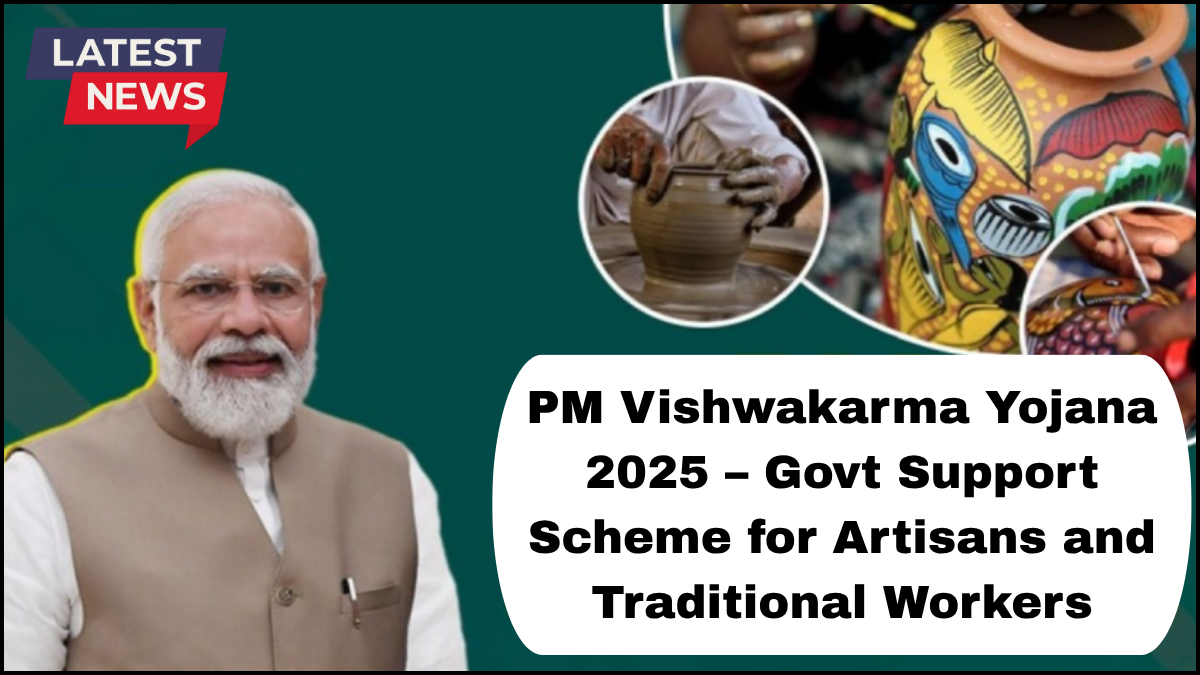The PM Vishwakarma Yojana 2025 is a focussed initiative by the Government of India, designed to uplift and economically empower artisans and traditional workers across the country. Under this Artisan Welfare Scheme, the government offers financial assistance, skills training, and support to sustain traditional craftsmanship in the modern economy.

What Is PM Vishwakarma Yojana?
Born from a vision to preserve India’s cultural heritage, the PM Vishwakarma Yojana embraces centuries-old artisanal crafts. It provides artisans with formal recognition, access to entrepreneurial tools, and financial resources to grow. The scheme targets artisans who otherwise operate in informal, unstructured setups.
Key Features of the Artisan Welfare Scheme
Financial Assistance and Credit Support
Under this scheme, registered artisans are eligible for low-interest loans to invest in tools, raw materials, technology, or workspace upgrades. In many cases, the government subsidizes interest rates, making credit viable even for individuals with limited collateral. A typical package includes loans up to ₹50,000–₹75,000 per artisan, depending on trade and region.
Skill Enhancement and Training
The yojana encourages participation in skill development workshops, often in partnership with vocational institutes. Topics include modern design techniques, digital marketing, sustainable production, and quality control. These workshops help artisans refine traditional techniques while adapting to evolving consumer trends.
Market Linkage and Brand Promotion
Through exhibitions, fairs, and online marketplaces, artisans gain exposure to domestic and international buyers. The government organizes village-level events and regional trade fairs to connect artisans directly with customers, bypassing middlemen. This approach promotes higher earnings and broader visibility for age-old crafts.
Eligibility and Registration Process
Who Qualifies?
Artisans engaged in handicraft, metalwork, woodwork, weaving, pottery, leatherwork, stone carving, and similar traditional trades can register. Registration is also open to self-employed craftspersons who traditionally operate in unorganized sectors.
How to Apply
Candidates must:
-
Register on the official PM Vishwakarma Yojana portal or visit designated government centers.
-
Provide proof of identity, residence, and proof of craft (e.g. sample work photos).
-
Submit a brief project proposal or plan explaining how they intend to use funds.
-
Receive a unique registration or ID number—often referred to as “Vishwakarma ID.”
Once approved, applicants can access sanctioned loans, training opportunities, and marketing support.
Benefits for Artisans
Stabilized Livelihoods
With secured loans and access to training, artisans can expand their operations—invest in better facilities, buy higher-quality raw materials, or diversify into new product lines. This leads to steady incomes and reduced financial vulnerability.
Preservation of Traditional Crafts
By supporting artisans directly, the policy ensures continuity in heritage crafts such as Kashmiri woodwork, Madhubani painting, and Channapatna toys. New generations get motivated to learn these crafts, keeping them alive for future years.
Increased Competitiveness
Access to digital platforms and design workshops helps artisans improve product quality and appeal. When artisans blend traditional methods with modern aesthetics, their goods attract broader customer segments.
Example Success Stories
-
In Rajasthan, a leatherworker cooperative accessed a government-backed loan, enabling them to buy new sewing machines and expand into export-quality footwear.
-
In Tamil Nadu, a small weaving group adopted new dyeing techniques learned through government-sponsored training, then showcased their textiles at a national expo—leading to bulk orders from urban boutiques.
These anecdotes showcase the real impact of the Artisan Welfare Scheme in transforming lives and livelihoods.
Challenges and Improvements
Administrative Hurdles
Some artisans find navigating paperwork and online portals difficult. To address this, the government has introduced simplified mobile-based registration and outreach camps in remote areas.
Awareness Gaps
In certain regions, word of the scheme hasn’t reached traditional artisans. Government agencies and NGOs are working together to raise awareness through local meetings, radio programs, and craft cluster events.
Ensuring Quality Standards
To maintain trust in artisanal products, quality control protocols and certification processes have been introduced. Artisans who successfully complete training workshops earn certification, which helps them command better prices.
Future Direction of the Artisan Welfare Scheme
Looking ahead, the scheme plans to include:
-
Cluster-level production units—shared facilities for groups of artisans to co-work, reducing individual overhead costs.
-
Incubation support—mentoring by designers, e‑commerce experts, and business advisors to help artisans scale.
-
Green and sustainable craft promotion—encouraging natural dyes, recycled materials, and eco‑friendly processes.
Frequently Asked Questions (FAQ)
Q1: Who is eligible under PM Vishwakarma Yojana 2025?
A: Any artisan or traditional worker operating in the unorganized sector—such as weaving, wood carving, metalwork, pottery, leather crafts—who registers with the official portal and meets verification criteria.
Q2: What is the maximum loan amount available?
A: Loans typically range between ₹50,000 to ₹75,000 per artisan. Exact amounts depend on trade, location, and implementation strategies through the scheme.
Q3: Are interest rates subsidized?
A: Yes. The government offers reduced interest rates or partial subsidies to make credit more affordable for artisans without collateral.
Q4: Do I need to have prior experience with computers or digital tools?
A: Not necessarily. The scheme includes training programs to help artisans learn digital marketing, e‑commerce, and other tech-driven skills from scratch.
Q5: Can artisans participate in exhibitions themselves?
A: Yes. The scheme organizes regional and national fairs. Artisans can directly showcase and sell their products under government networks, often with logistical support.
Q6: Is there support for craft clusters or cooperative groups?
A: Absolutely. The scheme encourages formation of clusters or cooperatives, enabling shared use of resources, larger production, and collective marketing.
click here to learn more
